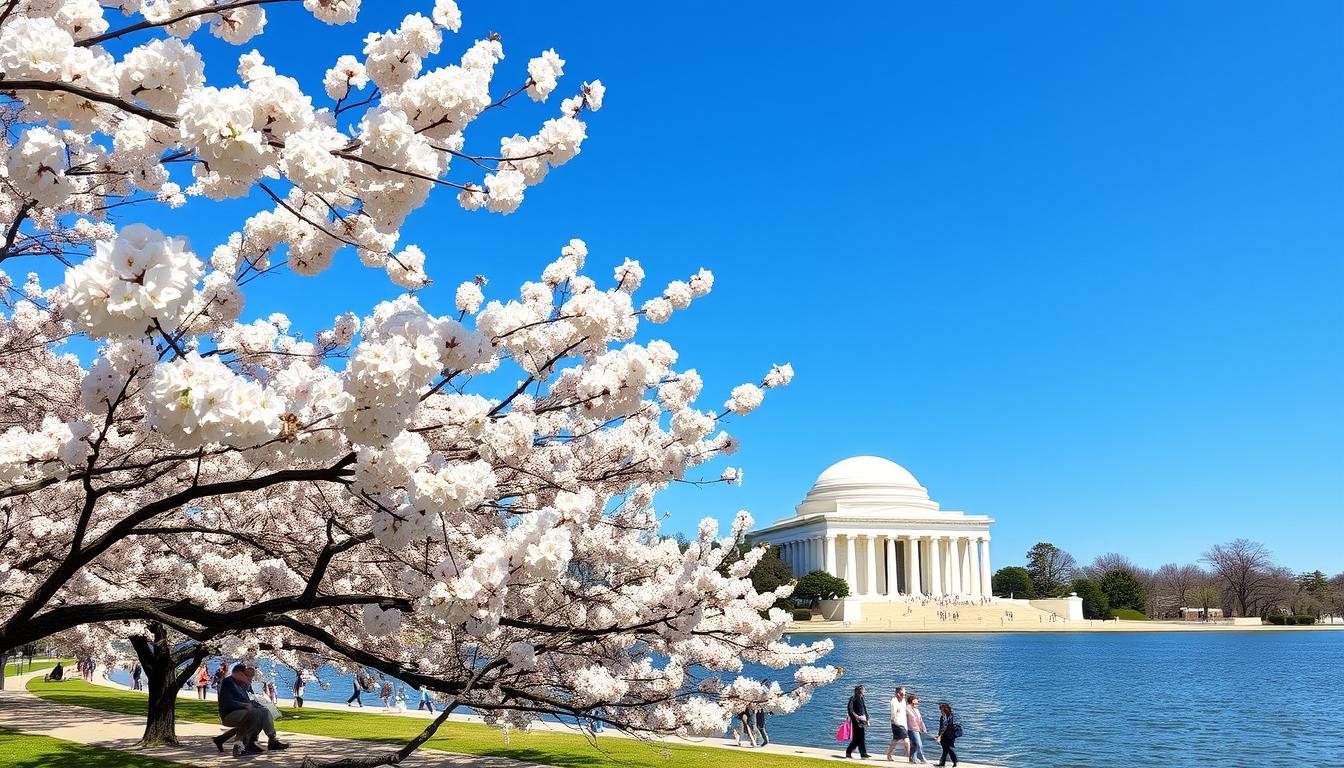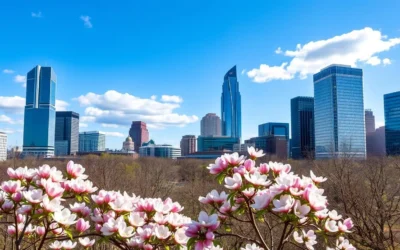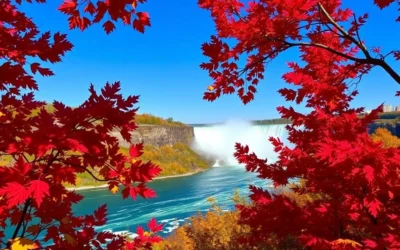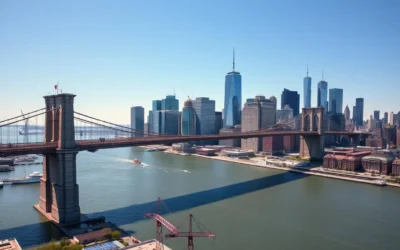Do you dream of exploring Washington DC’s landmarks and vibrant culture? But, you worry about the unpredictable weather? Don’t worry, we’ve got you covered. We’ll show you the best months to visit for a weather-wise adventure.
Get ready to discover the perfect times to enjoy the city’s wonders. From the cherry blossom blooms to the cozy fall foliage, it’s all here.
Key Takeaways
- The best time to visit Washington DC is typically in the fall (September to November) for comfortable weather and smaller crowds.
- Spring (late March to early April) is also popular due to the National Cherry Blossom Festival, but expect larger crowds.
- Summers can be hot and humid, while winters are cold with occasional snowfall.
- Peak tourist seasons can lead to long lines at attractions and premium hotel rates.
- Exploring the city on foot and experiencing the changing seasons are some of the best ways to immerse yourself in the city’s charm.
Understanding DC’s Four Distinct Seasons
Washington D.C. has a seasonal guide with four clear seasons: spring, summer, fall, and winter. Each season has its own climate and temperature patterns. This offers visitors a wide range of experiences all year long.
Spring (March-May)
Spring in D.C. is mild, with temperatures in the 60s°F. It’s the best time to see the city’s famous cherry blossoms. The National Cherry Blossom Festival is a highlight, celebrating the city’s spring beauty.
Summer (June-August)
Summer in D.C. is hot and humid, with temperatures in the 80s and 90s°F. Despite the heat, there are many outdoor events and festivals. These activities make the most of the warm weather.
Fall (September-November)
Fall in D.C. is mild, with beautiful leaves and comfortable weather. It’s a favorite time for visitors. The foliage and events in September and October make it a picturesque season.
Winter (December-February)
Winter in D.C. is cold, with temperatures from the 30s to 40s°F. The city gets about 15 inches of snow. Despite the cold, D.C. turns into a winter wonderland, offering a unique view of the city.
Washington D.C. offers a seasonal guide all year. With diverse climate and temperature experiences, there’s always something for visitors to enjoy.
Peak Tourist Seasons and Crowd Management
Washington, D.C. is a favorite spot all year, but some times are busier than others. Spring, especially during the Cherry Blossom Festival, summer, and holidays like Memorial Day, 4th of July, Thanksgiving, and Christmas are the busiest. If you want to see fewer people, try visiting in the fall or winter.
To deal with the crowds, check out less famous spots and use Metro stations away from the main sights. Also, book your hotel early for busy times, as prices go up during weekdays because of business travelers.
- Explore off-the-beaten-path attractions to avoid peak crowds
- Use Metro stations farther from popular sights to bypass the masses
- Book your accommodations early for peak tourist seasons
- Expect higher hotel rates during the week due to business travelers
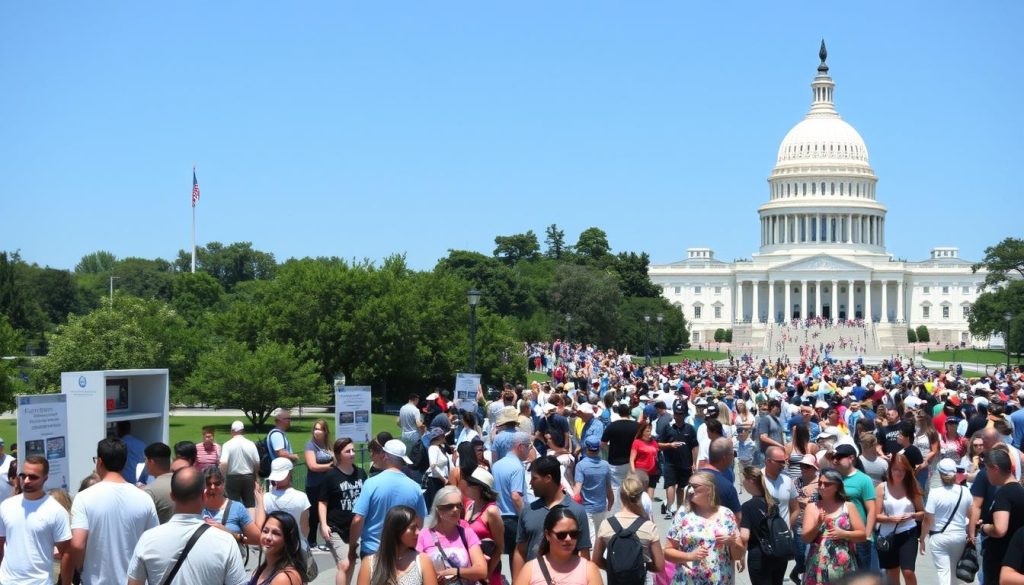
“The key to a successful trip to Washington, D.C. is knowing when to visit and how to navigate the crowds. With a little planning, you can experience all the city has to offer without feeling overwhelmed.”
Spring in DC: Cherry Blossoms and Mild Weather
Washington DC comes alive in spring. The Cherry Blossom Festival is a highlight, with the Tidal Basin filled with colorful blooms. This festival, in late March to early April, draws visitors from everywhere.
National Cherry Blossom Festival Highlights
The National Cherry Blossom Festival celebrates DC’s bond with Japan. It features parades, cultural shows, and the blooming of 1,800 cherry trees. After a two-year break, it’s back from March 20 to April 17.
Spring Temperature Ranges
Spring in DC is mild, with temps from the 50s to 70s°F. But, spring can be unpredictable. So, pack layers for the changing weather.
What to Pack for Spring
- Light jacket or sweater for cool evenings
- Comfortable walking shoes
- Umbrella or rain jacket for occasional showers
- Sun protection, such as sunscreen and sunglasses
- Versatile clothing that can be easily layered
The spring weather in DC is perfect for exploring outdoors. With the cherry blossoms in bloom, it’s a feast for the eyes. It’s a great time to enjoy DC’s culture and history.
Summer Heat and Humidity: Navigate Like a Pro
Summer in Washington DC tests your weather endurance. Temperatures often hit the 80s and 90s, with humidity around 60%. July is usually the hottest and most humid month. But, there are ways to manage the summer heat and humidity and enjoy your DC adventure.
First, pack lightweight, breathable clothing. Cotton and linen are great for summer. Choose items that can be layered or mixed for changing weather. And remember to stay hydrated – carry a refillable water bottle and drink often to fight the heat.

When it’s too humid, use the city’s air-conditioned spots. Museums, galleries, and indoor attractions offer a cool escape. They let you enjoy the city’s culture without the heat.
Watch out for afternoon thunderstorms, especially in July. Keep a lightweight rain jacket or umbrella ready. A passing shower shouldn’t stop you. Instead, enjoy the cool and the city’s lively energy on rainy evenings, when outdoor concerts and movies are on.
By following these tips, you can handle the summer heat and humidity in Washington DC like a pro. Your vacation will be filled with fun experiences, not just sweat.
Fall: The Perfect Balance of Weather and Activities
Washington DC welcomes fall with a refreshing change. This season brings a perfect mix of weather and outdoor fun. Temperatures range from the 50s to 70s Fahrenheit, making it great for exploring the city.
Fall Foliage and Outdoor Activities
Fall in DC is known for its beautiful foliage. Trees turn red, orange, and yellow in October. It’s a great time for hiking, biking, and walking in the city’s parks and gardens.
September and October Events
Fall in DC is filled with exciting events. The Library of Congress National Book Festival happens in September. October brings the Marine Corps Marathon, a big event for runners.
Temperature and Rainfall Patterns
Fall is the driest season in DC, with less rain. The weather is mild, perfect for outdoor fun. Remember to pack layers and wear comfortable shoes.
Fall in Washington DC is ideal for enjoying the city. The weather is nice, and there are fewer crowds. It’s a great time to see the city’s culture, landscapes, and activities.
| Season | Average Temperature | Precipitation |
|---|---|---|
| Fall (September-November) | 50-70°F | Lowest rainfall of the year |
| Winter (December-February) | 30-50°F | Moderate rainfall, potential for snow |
| Spring (March-May) | 50-70°F | Moderate rainfall, blooming flowers |
| Summer (June-August) | 70-90°F | Highest rainfall of the year, hot and humid |
“Fall in Washington DC offers the perfect balance of pleasant weather and fewer crowds, making it an ideal time for visitors to experience the city’s vibrant culture, stunning landscapes, and abundance of activities.”
Winter in Washington DC: A Different Perspective
Washington DC is famous for its warm springs and hot summers. But, its winters are special too. When it gets cold and snowy, the city turns into a magical place.
January is the coldest month, with highs around 43°F (6°C) and lows of 29°F (-2°C). The city gets about 15 inches (38 cm) of snow, mostly in January and February. The cold weather means fewer people and shorter lines at museums and indoor spots.
The winter in DC is enchanting, with the National Christmas Tree and holiday lights. You can ice skate at the National Gallery of Art Sculpture Garden or enjoy cozy cafes. There’s plenty to do in the cold.
To enjoy DC in winter, wear warm, waterproof clothes and sturdy boots. With the right gear, you’ll have a memorable visit.
| Metric | Average Value |
|---|---|
| Average January Temperature | 43°F (6°C) high, 29°F (-2°C) low |
| Average Snowfall per Season | 15 inches (38 cm) |
| Average Daylight Hours in December | 9 hours |
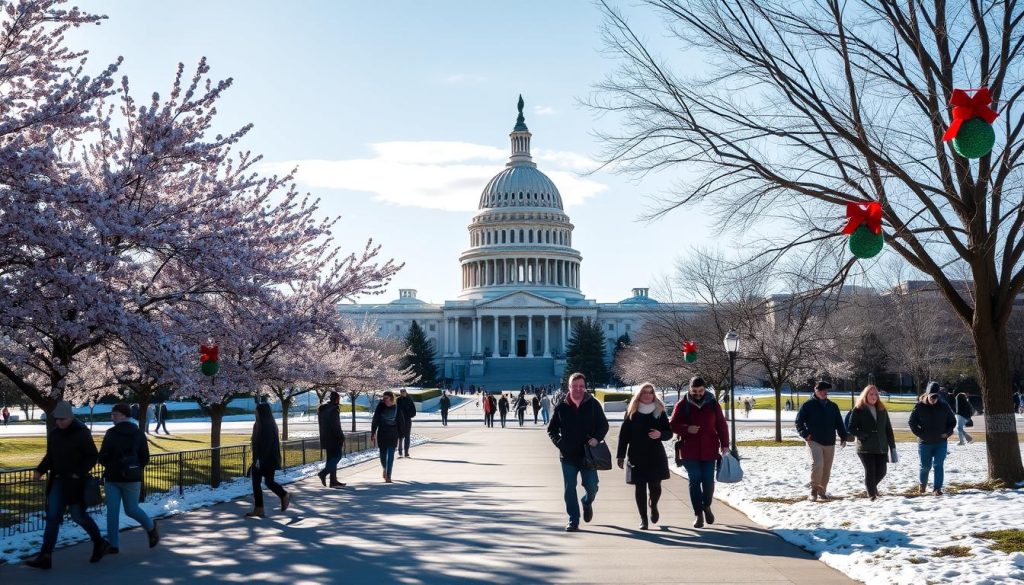
“The true beauty of winter in Washington DC lies in the city’s ability to transform and offer a different perspective on the iconic landmarks and experiences that draw visitors year-round.”
Washington DC, United States: Best Months for a Weather-Savvy Trip
Planning a trip to Washington DC? The best times are March to early April and September to November. These months have mild weather, fewer crowds, and great outdoor and sightseeing activities.
March to Early April Benefits
Spring in DC is magical, especially with the Cherry Blossom Festival. Temperatures are in the 50s to 70s Fahrenheit. This makes it perfect for walking in parks and seeing monuments.
The weather is also great for outdoor photos of the beautiful blossoms.
September to November Advantages
Fall in Washington DC is a nice break from summer’s heat. Temperatures are in the 50s to 70s Fahrenheit. It’s great for seeing the city’s fall colors and enjoying outdoor activities.
The crowds are smaller, making visits to famous landmarks more peaceful.
Visiting in spring or fall is ideal. You get comfortable weather, beautiful sights, and fewer people. It makes for a memorable trip.
Indoor Attractions for Weather Challenges
When the weather in Washington, DC, gets bad, indoor activities are a great escape. The city has many top museums and cultural spots perfect for rainy days.
The Smithsonian museums, like the National Air and Space Museum and the National Museum of American History, are free and open every day but Christmas. Art lovers can enjoy the National Gallery of Art. The United States Holocaust Memorial Museum offers a powerful and thought-provoking visit.
The Newseum is great for those interested in current events. It shows the importance of journalism and the media. Many of these indoor attractions are near the National Mall. This makes it easy to add museums and indoor activities to your rainy day plans.
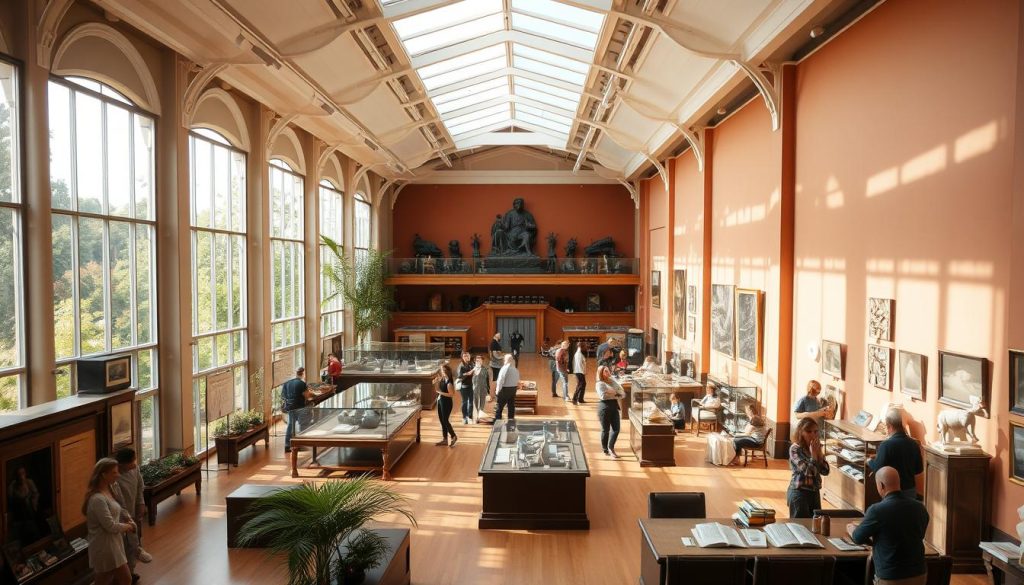
When it rains or snows, Washington, DC’s indoor activities are a cozy and educational way to spend the day. The city’s museums are a safe haven from the weather challenges. They offer a chance to explore the nation’s capital’s rich history and diversity.
Monthly Precipitation and Daylight Hours Guide
Planning a trip to Washington D.C.? It’s key to know the city’s rainfall patterns and daylight hours. This knowledge helps you pack right and enjoy your visit more. The city’s weather changes a lot throughout the year.
Rainfall Patterns
Washington D.C. gets about 3-4 inches of rain each month. May is the wettest month with 4.3 inches. Winter months have less rain, but the city’s rain stays pretty steady all year.
Seasonal Daylight Changes
Daylight hours in Washington D.C. change a lot. In summer (June-August), you get up to 14 hours of daylight. Winter (December-January) brings around 9 hours. These changes affect your plans for sightseeing and outdoor fun.
| Month | Average Rainfall (inches) | Average Daylight Hours |
|---|---|---|
| January | 3.12 | 9 |
| February | 3.01 | 10 |
| March | 3.58 | 11 |
| April | 3.34 | 12 |
| May | 4.30 | 13 |
| June | 3.87 | 14 |
| July | 3.64 | 14 |
| August | 3.36 | 13 |
| September | 3.19 | 12 |
| October | 3.12 | 11 |
| November | 3.14 | 10 |
| December | 3.18 | 9 |
Strategic Travel Planning Around Weather Events
When planning your trip to Washington, D.C., it’s key to think about the weather and major events. This way, you can enjoy your visit to the nation’s capital to the fullest.
The spring and fall are the best times for weather, with mild temperatures and less humidity. But, these seasons also see big crowds, especially during the Cherry Blossom Festival. If you want to avoid the crowds, try visiting in summer or winter. The weather is extreme, but there are fewer people around.
Summer in D.C. is hot and humid, with the Fourth of July and the Smithsonian Folklife Festival bringing in huge crowds. The heat can be tough, but these events are unforgettable. Winter, on the other hand, is cold and might snow, but it’s less crowded. You can enjoy holiday decorations and festive markets without the big crowds.
The above is subject to change.
Check back often to TRAVEL.COM for the latest travel tips and deals.
Here are some Tours & Sightseeing suggestions that might pique your interests!
